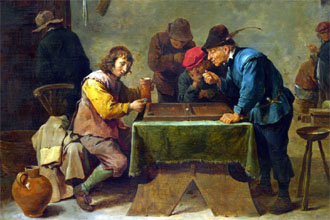|
| Magriel's NYT Columns |
 In any game of backgammon, the most important decision a player has to make is usually not about the play of the checkers, but concerns the doubling cube. Decisions to be made with the doubling cube fall into two categories: when to double, and when to take.
In any game of backgammon, the most important decision a player has to make is usually not about the play of the checkers, but concerns the doubling cube. Decisions to be made with the doubling cube fall into two categories: when to double, and when to take.
Many players agonize over accepting the cube, but tend to underestimate the importance of knowing when to double. For example, doubling with an insufficient lead will often backfire at considerable cost.
Even if you are very far ahead, you may not wish to double or redouble; you may have good prospects of gammoning your opponent, and very little chance of losing the game. To double in such a situation would allow your opponent to pass, and lose only half as much as he would if you gammoned him. The theory of when the position is too good to double, i.e., when it is correct to play on for a gammon, is often poorly understood.
In the diagrammed position a serious doubling misjudgment was made by a strong player. Black now owns the cube and had earlier refrained from doubling in hopes of gammoning White. On the previous roll, however, Black rolled an unfortunate 3-3 that forced him to break his 4- and 5-points, leaving two men on the 6-point, as shown.
|
| Black on roll. |
If Black is hit, he will have very little chance to win, because he will have taken just three or four men off. Aware of this danger, Black decided to redouble, and White was forced to pass. Black claimed a sure two points instead of speculating on either winning four points or losing the game. Did Black make the right decision?
In order for it to be worthwhile to play on for a gammon, you must gammon your opponent at least twice as often as you lose the game. In the diagrammed position, an analysis reveals that Black will win four times as often as he loses — Black is better than a 4-to-1 favorite. Because this is more than 2-to-1, the correct decision is to play on for the gammon. By losing courage and doubling, Black actually gave up a signficant amount of equity.
The best way to see why Black is a 4-to-1 favorite is to examine exactly what must happen for Black to lose: (1) Black must leave a shot (probability about 2/3); (2) White must then hit (probability about 1/3); (3) White must still win after hitting (probability less than 9/10). The probability that all three of these events occur is the product of the individual probabilities:
|
In the language of odds, this means that Black is at least a 4-to-1 favorite.
Rollout
 Tom Keith 2013 |
|
Money play Black owns 2-cube Black on roll 1296 games with VR Checker play: 2-ply Cube play: 3-ply Red |
| Cube Action | Game | G | BG | Equity | |||||
| No double |
W L |
.8197 .1803 |
.7765 .0000 |
.0011 .0000 | +1.4281 |

| |||
| Double | Take |
W L |
.8203 .1797 |
.7775 .0000 |
.0011 .0000 | +2.6481 | +1.0000 | (0.4281) | |
| Drop | +1.0000 | ||||||||

|
|

